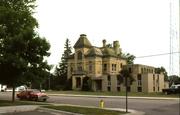| Additional Information: | A 'site file' exists for this property. It contains additional information such as correspondence, newspaper clippings, or historical information. It is a public record and may be viewed in person at the Wisconsin Historical Society, State Historic Preservation Office.
The NR in the photo code is short for NR roll.
A low center dome and concrete trimmed brick parapet top the three-story Calumet County Courthouse, whose two red brick upper stories are spported by a rusticated ground story of concrete block. A projecting center pavilion across the front (south) facade frames the shallow engaged two-story portico with its red brick pilasters. Concrete (Ionic) capitals and bases match the ground story, as well as the sills and alternating voussoirs above the rectangular windows on the upper stories.
On the ground story, windows are set within regularly-spaced round headed openings. Aluminum-frame plate glass double doors and a lunette replace the original glazing in the center entry. A heavy, bracket-trimmed entablature separates the third story from the parapet on the original portion of the building; a recession of the front wall, absence of cornice, brick window frames, and brick ground story identify the large three-story addition completed in 1976. Carried across the original building, a matched concrete foundation and water table continue along the front and side of the east end addition, stretching alongside the one-story 1960s addition to the rear of the property. The newer portions house the sheriff's department, jail, and the new corrtroom; they are not considered significant to the nomination.
The three-story rotunda which once dominated the center of the interior was truncated to two stories in the 1960s; a courtroom (now assembly room) was created in the space generated. Offices created by introduction of walls and accoustical ceilings now occupy the second and third story courtrooms. Although most wall surfaces are still painted plaster, successive cosmetic alterations have obscured the original character of the interior. The original wrought iron railings are still visible in the remaining two stories of the open rotunda.
Despite progressive additions, the original portion of the building retains the features and intended dignity of the design. The wide front lawn is accented by trees and shrubs and contemporary lamp posts installed with the 1976 addition.
Architectural Significance:
A decendant of the classical tradition in civic architecture and of the renewed academic fervor promoted by the World's Columbian Exposition in the 1890s, the Calumet County Courthouse well represents a period of construction. Differing only in minor details from the Taylor County Courthouse (NRHP 1980) in Medford, Wisconsin, the Calumet County building was also designed by architect B. Mehner in 1913. Likewise suited to its small town location, the Chilton courthouse conveys its local significance in scale and in the formal disposition of applied colonnade, dome, and constrasting rusticated concrete ground story, voussoirs, and entablature; the brick veneer building is otherwise servicable in nature.
Historical Significance:
Construction of a formal county courthouse in Calumet County did not begin until 1859, twenty-three years after the county was established. Until 1840, the mother county of Brown retained political and judicial responsibility for the region; at the time that it assumed its own government, the county was instructed to meet at "Whitesborough," but lacking knowledge of its whereabouts, the county gathered at Stockbridge. (See Bib. Ref. C).
In 1853 after the typical struggle among competing communities, the seat moved to Chilton. The first courthouse was completed in 1865, and the sheriff's residence and jail were completed in 1874. In the latter half of the 1890s, the county offices moved from the courthouse building to the former city hall across the street, and a seriff's office and jail were constructed at the rear (north) end of the courthouse lot. (See Bib. Ref. D). Shortly after the present courthouse building was completed (on the site of the previous frame building), an addition was made to the county office building across the street to house county prisoners; a second addition was made to the then-jail building in the 1960s. |
|---|
| Bibliographic References: | A. County Records.
B. 1976 Courthouse addition dedication plaque.
C. Willima A. Titus, editor, History of the Fox River Valley, Lake Winnebago, and the Green Bay Region, Vol. II, S.J. Clark Co., 1930.
D. Sanborn-Perris Maps of Chilton, Wisconsin, 1892, 1898, 1902, 1914.
E. APPLETON POST CRESCENT 3/30/1995.
F. NRHP ISF FORM.
G. MANITOWOC HERALD TIMES REPORTER 3/31/1995. |
|---|





